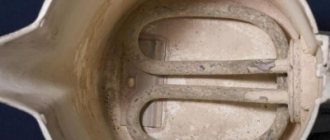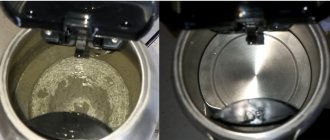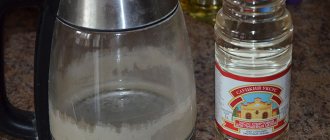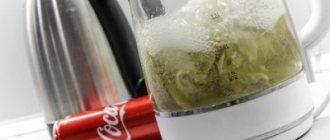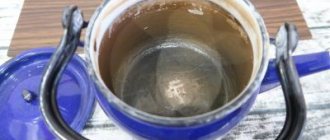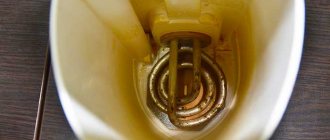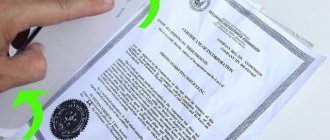Folk remedies
Vinegar Soda Lemon or citric acid Cola and other carbonated drinks Cucumber pickle Potato or apple peels
Special means
Antiscale Un Momento Tablets Frau Schmidt “Antinscale” Bagi Kumkumit
In the water that we pour into the kettle every day and use for cooking, the level of harmful substances is much higher than normal. Scale in a kettle and other heating objects is divided into three types: carbonate, sulfate and silicate. The first contains a large amount of magnesium and potassium salts, and the last two are dominated by magnesium, calcium, iron and aluminum salts.
Even the best filter is not able to purify tap water to perfect condition. During the process of boiling water, the sonicated salts disintegrate into carbon dioxide and solid sediment. This is what forms the scale.
If you do not pay attention to the white coating and do not clean the dishes from it, its layer will grow over time. The rate of formation is affected by the hardness of the water and the quality of the heating element.
Source: Unsplash (@jtylernix)
For example, in a new kettle, scale will form more slowly. But if you clean it with aggressive substances or don’t care for the teapots at all, then after a few months the process of scale formation will accelerate. The more scale there is, the longer the kettle will boil, which means it will waste more electricity. It will all end with a breakdown of the heating element.
If you regularly drink tea or coffee with water from a kettle with limescale, you can harm your health. After the white plaque dissolves in the stomach, harmful compounds enter the blood, which then carries them throughout the body. Doctors call this process reabsorption. As a result, harmful salts are deposited in the joints, provoke the appearance of stones in the kidneys and gall bladder, and can also cause blockage of blood vessels.
By the way
Residents of Moscow can find out the hardness of the water supplied to their homes on the Mosvodokanal website. To do this, you need to go to the “Water quality in Moscow regions” section and enter your address.
To prevent all this from happening, we’ll tell you about 6 simple ways to descale a kettle at home without harming yourself or the dishes.
What is scale and why must it be removed?
Sometimes on the Internet you can find the opinion that it is not necessary to remove scale - it is a purely visual defect, which plays a role only in glass teapots. This statement is completely wrong.
First of all, you need to understand how scale appears. Most often, ordinary running water is used for boiling, which contains quite a lot of impurities. However, they are found in both bottled and filtered water - albeit in smaller quantities.
Most of them are various salts, which, when heated, are separated into carbon dioxide and a solid sodium precipitate, which remains on the walls of the dish. However, it is not washed off with ordinary water and tends to accumulate.
The problem of scale is not only an unaesthetic appearance
Such deposits harm your kettle: it impairs thermal conductivity, which means it will take more time to heat up. Because of this, in conventional kettles the layer of ceramic coating, if any, gradually becomes thinner, and in electric kettles the heating elements fail faster.
However, this factor can be considered rather secondary. The main reason you should deal with scale is because of the potential health risks. Since plaque consists of sediments of salt, insoluble metals and various harmful impurities, including chlorine, sediment entering the body can contribute to the development of various diseases. The mixture can provoke arthritis, gout, osteochondrosis, kidney stones or toxicological poisoning.
That is why you need to clean the kettle from plaque regularly. In the following sections we will talk about how to do this correctly.
Household chemicals
For cleaning, it is effective to use not only home remedies. Store-bought formulations are more expensive, but they allow you to quickly achieve results. However, it is relatively safe. That is, use is only permissible according to the instructions, otherwise there will be harm to health. Failure to comply with dosages will ruin the surface of the partings. In addition, after cleaning you need to rinse off the composition very carefully.
Popular means:
1 Aqualon - for use, add three-quarters of water and drop 1 tablet. After boiling comes cooling and rinsing. If the scale does not come off, then wipe it with a soft sponge.
2 Fresh – using the product, do not bring water to a boil. One tablet is placed in cold or warm water (the effect is better in warm water) for 10 minutes. Then everything is rinsed and boiled with clean water several times.
3 Calgon - designed for washing machines, but works great with electric kettles. Add half a teaspoon of powder to 1.5 liters of water. Everything is boiled once and washed.
4 Antiscale - use in accordance with the proportions in the instructions. Boiling time varies depending on the thickness of the coating. The acids included in the composition allow you to quickly remove lime deposits.
How often should you descale your kettle?
The answer to this question depends on two factors - the type of heating device and the quality of the water you use.
Glass teapots need to be cleaned almost every week: any plaque, even the thinnest one, is noticeable on the transparent surface. But metal or ceramic ones can be cleaned of plaque about once a month - as they become dirty.
In addition, kettles with an open heating coil require cleaning more than those with a closed heating element. Otherwise, the device will fail faster.
As for the quality of water, see for yourself. Bottled or well-filtered water pollutes the kettle less, but it is not a panacea - only distilled water does not produce sediment at all, but we do not recommend anyone to drink it - it is too harmful to health.
The quality of tap water depends on the water supply service, its source, and even the condition of the pipes in your home. Sometimes it is enough to clean the kettle once every couple of months, and sometimes after just a week a thick layer of scale forms in the tank.
Therefore, the decision on the frequency of cleaning your kettle is up to you - it is impossible to give an exact answer remotely.
Let's move on to specific recommendations.
Causes of plaque formation
Scale is a hardened deposit that covers the bottom and walls of the kettle during long-term use. It is formed due to salts in the water. The scale layer may vary in color. The shade depends on the composition of the water.
- White-yellow. Indicates calcium-magnesium plaque.
- Bright white. Characterizes the high content of chlorine in tap water.
- Red tint. Indicates the predominance of iron.
Scale must be removed not only for fear of the development of pathogenic microorganisms. The thick layer formed inside the kettle causes the boiling to slow down. And if this does not harm ordinary dishes, then electrical appliances designed for a certain boiling time begin to wear out. This leads to their rapid failure.
How to prevent scale formation
You will hardly be able to completely avoid the appearance of precipitation - unless you really use crystal clear water, with a minimum of heavy impurities. However, it is quite possible to reduce the amount of scale.
To do this, follow our recommendations:
- First of all, if the water quality in your home leaves much to be desired, invest in a good water filter. What it will be, cassette or streaming, is up to you. Personally, we recommend the faucet attachment - it is considered the most effective and economical option today.
- Do not leave water in the kettle. After drinking tea, some of the water is not used? Pour it out. This will make caring for the kettle much easier in the future.
- Try to regularly wipe the kettle with a soft sponge soaked in soapy water. If there is no old plaque on the surface, you can remove particles that have not yet adhered, which over time will turn into persistent sediment.
Tip : Even if you don’t have the opportunity to purchase a filter, try to let the water settle before boiling. A day will be enough.
Using these simple recommendations, you can make caring for your kettle easier and prevent the formation of a thick layer of scale.
If it was not possible to completely avoid the appearance of scale or you need to clean the old kettle, we recommend using our recommendations.
Method 1: Clean the kettle with citric acid
A banal food product that costs a couple of rubles, which can be found in any kitchen, can easily cope with mild to moderate scale. The procedure is not particularly complicated: fill the kettle two-thirds with water and add citric acid. The powder should be poured at the rate of one tablespoon for every liter of water.
Citric acid is one of the most affordable ways to descale a kettle
Then turn on the kettle and wait until the water cools down. Drain the water when it has cooled to room temperature. Then wipe the kettle with a soft sponge. If necessary, the procedure can be repeated two or three times in a row until the scale is completely gone. After this, boil the kettle again with clean water and wash it thoroughly.
The method is effective, but it will not cope with old scale that has ingrained itself into the surface. In addition, it is not suitable for enamel teapots - the surface of the latter may become dull from the aggressive effects of citric acid. But it can be used for both conventional and electric kettles.
Conclusions : Effective, budget-friendly and very simple method.
Is Coca-Cola a kitchen helper?
Yes, carbonated drinks can not only be used for their intended purpose, quenching thirst, but also used to tidy up kitchen utensils . You can clean the kettle with Coca Cola, Sprite and Fantoy not only from scale, but also from rust. The composition of Coca-Cola even copes with smoke on car carburetors!
First, get rid of gas bubbles by shaking the contents of the bottle. Then boil 0.5 liters of the drink in an electric kettle, pour it out and immediately wash the inside of the device. Sometimes the color of the soda can stay on the stainless steel, so try Sprite first - it doesn't have any dyes.
Method 2: Clean the kettle with lemon
For those who prefer to use the most natural products in the kitchen, citric acid can be replaced with lemon. As with the previous method, you should not experiment with enamel teapots unless you want the enamel to discolor or crack.
Cut the lemon into thin slices and place in a kettle filled two-thirds with cold water. Then boil it. Further, the procedure differs for conventional and electric kettles.
The most environmentally friendly way to clean a kettle
In the first case, you need to wait for the water to boil, and then keep the kettle on low heat for 20-30 minutes.
For an electric kettle, you need to boil it several times, after the water has cooled a little - on average, reviews recommend three boils with an interval of 10 minutes.
After the water has cooled completely, drain it and wipe the kettle with a soft sponge to remove any remaining deposits. Most often, a repeat procedure is not required, but if necessary, you can boil the lemon again. Bonus - a pleasant aroma that will spread throughout your kitchen.
How to quickly remove using special means?
In addition to folk remedies, you can use ready-made household chemicals . It is more expensive, but has a good effect. The release form in most cases involves liquid, gel or tablets.
Top House
Product made in Germany. It goes on sale in two forms: tablets and liquid. Designed for dissolving scale in teapots, coffee makers, coffee machines, as well as on ordinary dishes. The effect is due to the presence of organic acids in high concentrations. Top House has no smell. The bottle cap is made with a child safety feature.
The application algorithm is very simple. Pour a liter of water into the heating container, bring to a boil and turn off the device. After 5-6 minutes, pour 150 ml of cleaner (or 200 ml for thick deposits). Soaking should last 30 minutes. After this, the solution is drained and the container is washed.
When using a tablet product, take one tablet per liter of water (or two if heavily soiled). Further, the course of purification coincides.
The cost of a 500 ml bottle is approximately 250-280 rubles. The price of a package of tablets (8 pieces, 25 grams each) is on average 270 rubles.
Topper
A German-made liquid concentrate is designed to remove limescale in kettles, coffee makers and other water heating devices. Considered universal and environmentally friendly . The formula contains citric acid, surfactants (at least 5%) and auxiliary agents.
To clean, pour a liter of water into the container, then add 100 or 120 ml of Topperr. Heat the liquid to 50 degrees. For the reaction to take place in full, wait another half hour.
After the procedure, the kettle is thoroughly washed and a control portion of water is boiled. The cost of a 250 ml bottle ranges from 150-250 rubles.
Five Plus
The product is from a Russian manufacturer . The liquid is produced using the latest technology using colloidal silver. This ensures not only the removal of limescale, but also the disinfection of heating containers. The composition also includes a mixture of acids and an anti-corrosion additive.
The product does not leave any foreign smell or taste after cleansing, so it is suitable for teapots and coffee makers. The liquid is not used for enamel surfaces.
The manufacturer guarantees cleansing in just one procedure. To do this, pour two parts water and one part Five Plus into the tank. Bring the liquid to a boil, turn it off and leave for another 20-30 minutes.
After this, the solution is drained, the kettle is washed and rinsed twice. A 500 ml bottle can be purchased for 200-250 rubles.
When using ready-made chemicals, you must be careful and wear gloves . If the product comes into contact with the mucous membranes of the eyes, it is necessary to rinse them with plenty of water.
Method 3: Clean the kettle with vinegar
First of all, it should be noted that this technique is not suitable for electric kettles: vinegar can only be used for ordinary metal ones. However, for them this method is very effective and convenient.
As in previous cases, you need to fill the kettle two-thirds full. Add vinegar, about half a glass per liter. If you are using concentrated essence, you will need one and a half tablespoons for the same amount of liquid.
Measure the amount of vinegar carefully
Boil water and leave to cool for one hour. Then simply drain. Use a soft sponge to wipe stubborn stains and they will come off. After cleaning, you need to boil the kettle with plain water two or three times.
Important : Please note that vinegar emits a very strong aroma when heated, so you should only carry out the procedure with the windows open or a powerful hood turned on.
Additional cleansing
It may happen that after the first cleaning some of the scale remains. To remove everything completely, you will have to carry out additional surface treatment. Vinegar can be used as an additional cleansing measure. The vinegar and water solution must be left in the kettle for an hour. When time has passed, the dirty water must be poured out, and the surface of the kettle must be cleaned with the hard side of the sponge. To protect your hands from the acidic environment, it is advisable to use gloves. When all dirt has been removed, the kettle should be rinsed thoroughly with water. Then fill with water and bring to a boil.
Thanks to these recipes, you can learn how to descale a kettle without much effort. It is important to pay attention to the material from which the product is made. This is an important aspect to consider when choosing a cleaning product. This is the only way to achieve perfect cleanliness even with improvised means.
Method 4: Clean the kettle with soda
An inexpensive and healthy way to get rid of even the oldest and hardest scale is to use baking soda. It is suitable for all types of teapots, including enameled ones.
It is important not to overexpose the soda in the kettle
However, you should use baking soda carefully - it can scratch the surface, so don't try to just wipe off the plaque with it. In addition, in order to get rid of the old layer of scale, you will have to repeat the procedure at least three times.
Add one tablespoon of soda to half a kettle of water (no more!). For a regular kettle, boil the water for half an hour. For electric, you need to turn on the boiling mode several times. Forum users claim that three to four times are enough.
Preventing scale formation
Of course, this problem cannot be completely avoided; scale will form again and again. But you can reduce the number of procedures to remove it to a minimum if you follow simple recommendations:
- Use filtered water. If there is no filter, buy a bottled one. In any case, water straight from the tap is not advisable, especially if it is hard.
- Do not boil the same water several times. Pour it into a jug, and after each boiling, rinse the kettle with water.
- Do not allow scale to accumulate, do preventative cleaning.
Method 5: A mixture of vinegar and soda for cleaning teapots
As everyone knows, when soda is added to vinegar, a chemical reaction occurs. You can use it to clean scale from a kettle, but you should be careful - you can’t just fill the kettle with vinegar and add baking soda. Such an aggressive impact will damage the container.
When mixed, baking soda and vinegar produce an active chemical reaction.
You need to fill the kettle two-thirds full and add one tablespoon of baking soda per liter of water. Then pour half a glass of vinegar into the tank or add three tablespoons of vinegar essence.
Bring the water to a boil and keep the kettle on low heat for half an hour. Then use a soft cloth to wipe off any dirt. This method is not suitable for electric kettles, but it does an excellent job of cleaning old scale from regular ones.
How to remove strong old plaque?
Plaque that has formed over several months is difficult to remove, but possible. Recipes will help:
- simultaneous boiling with vinegar and soda. First, you need to pour about 5 liters of water and 50 g of vinegar essence into the device. When the water boils, add 20 g of soda. Keep on fire for a couple of minutes, let cool and remove plaque with a stiff brush;
- Another option is to first mix soda and fresh juice of 1 lemon, apply this mixture in a thin layer to areas where plaque accumulates, and leave for half an hour. Then add water and boil it. During this time, the scale will dissolve. Repeat the cleaning procedure if necessary.
- Soda ash is a fairly potent remedy. A tablespoon of the substance is enough for 1 liter; boil the solution for 5 minutes. During the procedure, you must keep the windows in the room open.
Method 6: Remove old scale with soda, vinegar and citric acid
This method cannot be called gentle: it has a very aggressive effect on the surface, so it is permissible to use it only if the kettle has not been cleaned for several months and a thick layer of scale has formed inside.
This method is only suitable for the oldest scale
In order to clean the kettle, you will need to boil water in it three times for 30 minutes. The first time - with a tablespoon of soda, the second time - with a tablespoon of citric acid, the third time - with half a glass of vinegar. For each case, water should fill the container by two-thirds.
After the last boil, carefully wipe the kettle with a sponge and then boil it several times with clean water. It is very important to ventilate the room well during the cleaning process, as vinegar emits an extremely unpleasant odor when heated.
If there is a lot of scale in the kettle...
No product can quickly deal with a thick layer of scale. It will take time for it all to dissolve or fall away. Necessary:
- Fill the kettle with a cleaning solution (vinegar, store-bought or other).
- Boil.
- Close the spout to prevent steam from escaping.
- Wrap with a towel.
- Leave for 3 hours.
- Boil the solution again and repeat steps 3-6.
- Drain the liquid, rinse the kettle and evaluate the cleaning result.
- If there is very little plaque left, you can remove it with an iron sponge, a stiff brush or a paste of soda.
- If there is strong scale, you need to prepare a fresh solution and repeat the procedure from the beginning.
The Internet is full of recipes that promise instant results. But if scale has been building up for months, none of them will work. We advise you not to waste time on dubious means and methods, but to be patient. In the future, preventive maintenance will eliminate lengthy cleanings.
Method 7: How to clean a kettle with Cola, Sprite or Fanta?
Oddly enough, however, this method has a right to exist.
First of all, a few rules:
- Do not use this method for electric kettles with an open heating coil - the sugar contained in drinks will cause much more damage to it than scale.
- For enameled surfaces, choose drinks without dyes, otherwise the shade of the container may change in a completely unpredictable direction.
- If there are scratches inside the kettle, you should also abandon this method - the dyes may become embedded in the damaged surface.
The cleaning process itself is quite simple. Fill the kettle halfway with the drink and turn it on. Leave it for about 20 minutes after the liquid boils. Drain it and rinse it with clean water.
Cola is not only a drink, but also an excellent cleaning agent
It sounds incredible, but even old scale can be cleaned this way. However, another question arises here - how safe it is to drink such drinks if they remove something that aggressive detergents cannot always cope with.
Method 8: How to clean a teapot with apple peelings.
Another method from the “Incredible but true” category. It doesn’t always work: if the scale is old, you won’t be able to get rid of it this way. But with plaque that has just appeared, the method works perfectly. In addition, it is considered one of the most gentle. It can be used for glass teapots - it is both environmentally friendly and will help give them shine.
The method is suitable for savings fans: no waste!
Simply boil two handfuls of apple peels in half a kettle of water for 20 minutes. For electric kettles, you can turn on the boiling mode 2-3 times. Then leave the device for two hours. After this, you can drain the liquid and wipe the inside of the kettle with a soft cloth. Rinse it well - the clean kettle is ready for use!
Method 9: Use brine to clean teapots
Frankly speaking, this method is not for everyone. It's hard to imagine a person who likes the smell of boiling brine. However, if you are not sensitive to fragrances and the naturalness of the product is important to you, you can experiment.
It is necessary to pour the brine into the kettle, boil and leave for half an hour. Then drain the brine and rinse the kettle with clean water.
Not everyone will like boiling brine.
True, not every brine is suitable - only one that contains vinegar or citric acid. It is through their action that the effect is achieved. But here the question arises: why boil the brine if you can just use acid or vinegar?
Method 10: Chemical descaling agents
If quick results are important to you and you don’t want to experiment with your own kettle, you can simply go to a hardware store and buy a descaler.
Antiscale, Cinderella, Shine... There are many options, for every taste and budget. We recommend that you carefully study the composition: some drugs should not be used, as they can have an aggressive effect on the coating of the kettle or cause harm to your health.
If you don't want to experiment with a teapot.
On the other hand, most safe products contain the same citric acid or soda as an active ingredient. So is it worth overpaying?
In any case, you can use any of the methods we have given - depending on the type of kettle you have, of course.
Tools that are always at hand
This article provides ways to clean a kettle at home. Tools that can be found in almost any kitchen will come to the rescue. After all, these products are used for cooking.
Due to the content of certain organic acids in them, these products are effective means for combating limescale in a kettle.
Every housewife definitely has baking soda and vinegar. For an improved effect, use calcined. Citric acid or fresh lemons are also an excellent remedy for solving such problems. And even apple peels or potato peelings will come in handy in this matter.
And a good housewife will certainly have several canned jars of tomatoes or cucumbers. Their brine does not need to be poured out.
Brine does an excellent job of removing scale from teapots due to its acetic acid content. Another very effective remedy is sweet carbonated drinks.
Let's consider which product is best suited for each type of kettle. But no matter what method you choose, it’s worth remembering one main rule: after cleaning, the kettle needs to be filled with water again, boiled, and then poured out. Thanks to this procedure, you can get rid of small particles of scale and cleaning agent residues.
